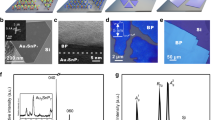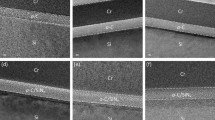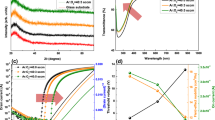Abstract
Cumulative layered structures of amorphous semiconductors have attracted much interest in recent years, as they make it possible to use quantum effects to improve semiconductor properties1. There is, however, a serious disadvantage in using such superstructures in practical devices, because the conventional process requires mechanical alternation of source gases and evacuation of the system for each layer deposition. As an alternative to this inefficient physically controlled method, we have developed an efficient photochemically controlled method which facilitates the continuous deposition of various superlattices. In combination with two modes of excitation, at least one of which is operated in a pulsed mode, an appropriately selected pair of source gases accumulates continuously binary layers of amorphous semiconductors. As an example of verification of this novel process, an amorphous super-lattice composed of an amorphous silicon carbide barrier layer and an amorphous silicon well layer was prepared from a mixture of disilane and carbon tetrafluoride.
This is a preview of subscription content, access via your institution
Access options
Subscribe to this journal
Receive 51 print issues and online access
$199.00 per year
only $3.90 per issue
Buy this article
- Purchase on Springer Link
- Instant access to full article PDF
Prices may be subject to local taxes which are calculated during checkout
Similar content being viewed by others
References
Abeles, B. & Tiedje, T. in Semiconductors and Semimetals Vol. 21, pt C, (ed. Pankove, J. I.) 407–425 (Academic, Orlando, 1984).
Vinzant, J. W., Shen, M. & Bell, A. T. in Plasma Polymerization (eds Shen, M. & Bell, A. T.) 79–85 (American Chemical Society, Washington DC, 1979).
Hamasaki, T., Ueda, M., Hirose, M. & Osaka, Y. J. non-cryst. Solids 59/60, 679–682 (1983).
Matsuda, A., Kaga, T., Tanaka, H. & Tanaka, K. J. non–cryst. Solids 59/60, 687–690 (1983).
Pollock, T. L., Sandhu, H. S., Jodhan, A. & Strausz, O. P. J. Am. chem. Soc. 94, 1017–1024 (1973).
Cvetanovic, R. J. in Progress in Reaction Kinetics Vol. 2 (ed. Porter, G.) 39–130 (Pergamon, Oxford, 1964).
Tiedje, T., Abeles, B., Persans, P. D., Brooks, B. G. & Cody, G. D. J. non-cryst Solids 66, 345–350 (1984).
Author information
Authors and Affiliations
Rights and permissions
About this article
Cite this article
Kawasaki, M., Matsuzaki, Y., Fueki, K. et al. A novel deposition concept for amorphous superlattices. Nature 331, 153–155 (1988). https://doi.org/10.1038/331153a0
Received:
Accepted:
Published:
Issue Date:
DOI: https://doi.org/10.1038/331153a0
This article is cited by
-
Making multilayered samples
Nature (1988)
Comments
By submitting a comment you agree to abide by our Terms and Community Guidelines. If you find something abusive or that does not comply with our terms or guidelines please flag it as inappropriate.



